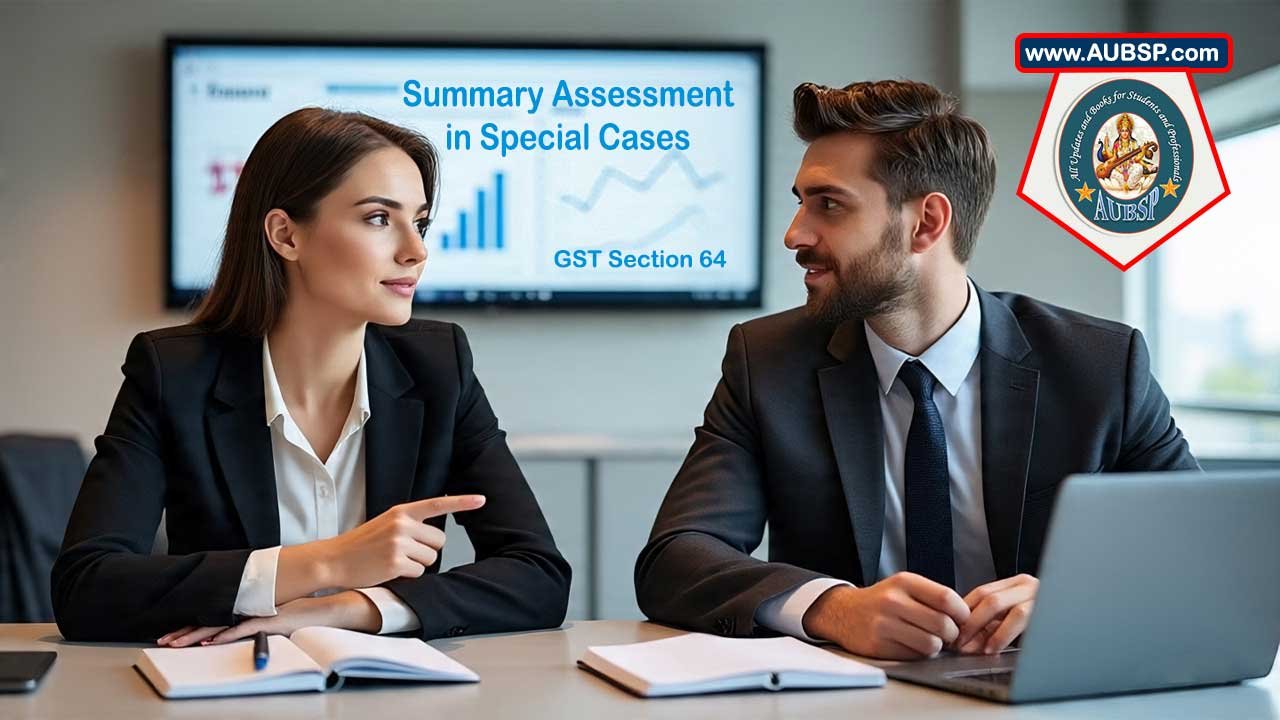Section 64 of the CGST Act, 2017 empowers GST authorities to conduct a summary assessment in urgent cases to protect government revenue. It allows officers, with prior approval from an Additional or Joint Commissioner, to assess tax liability based on clear evidence without following standard procedures, especially when delay could harm revenue interests.
The law also provides safeguards, including the taxpayer’s right to seek withdrawal of erroneous orders within 30 days and further reassessment under Sections 73, 74, or 74A. This provision ensures a balance between quick enforcement and fair taxpayer rights.
| Aspect | Details |
|---|---|
| Section Name | Section 64 – Summary Assessment in Special Cases |
| Applicable Law | Central Goods and Services Tax (CGST) Act, 2017 |
| Effective From | July 1, 2017 |
| Notification Reference | Notification No. 9/2017-Central Tax, G.S.R. 658(E), dated June 28, 2017 |
| Purpose | Protect revenue through urgent tax assessment in exceptional cases |
| Who Can Initiate? | Proper Officer with prior approval from Additional/Joint Commissioner |
| Form Used for Assessment | FORM GST ASMT-16 |
| When Taxable Person is Unknown | Person in charge of goods deemed taxable |
| Withdrawal Mechanism | FORM GST ASMT-17 within 30 days (by taxpayer) or by officer on own motion |
| Post Withdrawal Sections Applied | Section 73, 74, or newly inserted 74A |
| Recent Amendment | Section 64(2) amended to include Section 74A (via Notification No. 17/2024, effective 01.11.2024) |
| Type of Provision | Exceptional, fast-track, with checks and balances |
Understanding Section 64 of the CGST Act, 2017: Summary Assessment in Special Cases
Summary assessment under the CGST Act is a special provision invoked only in rare and urgent cases where revenue protection is at stake. Introduced through Section 64 of the Central Goods and Services Tax (CGST) Act, 2017, this provision empowers GST officers to swiftly determine and recover tax liabilities without the usual procedural delays.
But what makes this provision so special? And when can it be applied? In this article, AUBSP explains the complete breakdown of Section 64, its subsections, recent amendments, and how businesses can respond effectively.
What is Summary Assessment under Section 64?
Summary assessment is not a regular tool for GST officers. It is used only when there’s a risk of revenue loss due to delay. This extraordinary provision allows tax authorities to bypass detailed procedures and immediately issue an assessment order if they believe government revenue may be adversely affected.
Unlike self-assessment or scrutiny assessments that offer opportunities to respond and comply, Section 64 skips prior show-cause notices to enable fast-track action. However, it comes with checks like mandatory approval from senior officers and post-assessment safeguards. Let’s decode its application step-by-step.
Section 64(1): Power to Summarily Assess a Taxpayer
Subsection (1) of Section 64 grants authority to conduct a summary assessment under pressing circumstances. It can only be exercised if specific preconditions are satisfied to prevent misuse of power.
Key Conditions for Invoking Summary Assessment
To ensure fairness, summary assessments cannot be arbitrary. The following conditions must be met:
- Evidence of Tax Liability: A GST officer must possess concrete evidence that a person is liable to pay tax.
- Approval from Higher Authorities: The officer must get prior permission from an Additional or Joint Commissioner before taking any action.
- Urgency to Protect Revenue: There must be sufficient grounds to believe that delay in assessment will harm government revenue.
- Assessment Order Issued in FORM GST ASMT-16: Once approved, an order is issued in the standard format to fast-track the process.
This provision is especially useful in scenarios like unreported movement of goods, bogus billing, or non-declaration of liability where swift action is vital.
Special Proviso: When the Taxable Person is Not Known
A unique feature of Section 64(1) is its proviso dealing with cases where the actual taxable person cannot be traced. This ensures that tax recovery isn’t delayed or lost due to the inability to identify the liable party.
Who Becomes Liable in Absence of the Taxpayer?
If a person responsible for the tax cannot be located and the liability is linked to goods, then:
- ✅ The person in charge of the goods is deemed to be the taxable person.
- ✅ This deemed liability includes the payment of tax and any other dues under the section.
This helps the authorities take control of the situation, especially in cases involving interception of vehicles, non-compliance with e-way bills, or fake invoicing operations.
Section 64(2): Withdrawal of Erroneous Summary Assessment Orders
Even though summary assessments are fast-tracked, the law ensures that errors can be corrected. Section 64(2) lays out how an incorrect summary assessment order can be withdrawn either by the taxpayer or by tax authorities themselves.
Two Ways to Withdraw a Faulty Assessment
- By Application from the Taxpayer:
- The person can apply for withdrawal of the summary order within 30 days of receiving it.
- The application must be made in FORM GST ASMT-17.
- If found valid, the order may be withdrawn and the case processed under a regular assessment procedure.
- By Authority’s Own Motion:
- The Additional or Joint Commissioner who gave approval can withdraw the order themselves if they believe it was issued in error.
- This ensures internal accountability and checks within the tax department.
Once withdrawn, the case transitions to Section 73, Section 74, or Section 74A—whichever is applicable depending on the nature of the tax issue (fraud or no fraud).
Amendment Alert: Inclusion of Section 74A via Finance Act, 2024
With the introduction of Section 74A in November 2024, the CGST framework added another pathway for reassessing liability after an erroneous summary order. This amendment ensures a more categorized and streamlined approach to tax adjudication post-withdrawal.
What Does the Amendment Change?
- The amendment to Section 64(2), effective from November 1, 2024, added a reference to Section 74A.
- This allows authorities to now route cases through Section 74A, which may offer new or alternative remedial measures depending on the circumstances.
While full details of Section 74A require a separate discussion, its mention here highlights that GST law is evolving, and businesses must stay updated on how such provisions may impact assessments and liabilities.
Why Summary Assessment is Treated as an Exception, Not the Rule
Summary assessments are not the standard method of determining tax liabilities. It is used sparingly and only in urgent, exceptional situations. Compared to self-assessment, scrutiny, or best judgment assessment, this route offers speed but less procedural protection to taxpayers.
Balancing Revenue Interests and Taxpayer Rights
Despite its urgency, the law embeds key safeguards such as:
- Mandatory senior officer approval before initiating summary assessments.
- Right to appeal/withdrawal through application within 30 days.
- Post-withdrawal processing under Sections 73, 74, or 74A.
This balance ensures that while the government can act swiftly, taxpayers also retain their legal remedies and fairness.
Conclusion: Stay Informed, Stay Compliant
Section 64 of the CGST Act, 2017 serves as a vital protective tool for revenue authorities in situations of imminent risk. However, it is not immune to checks and reviews, and businesses have the right to seek withdrawal of such assessments when unjustified.
✅ AUBSP Pro Tip:
If you or your business receives a summary assessment order:
- Act promptly within 30 days.
- File for withdrawal using FORM GST ASMT-17 if the assessment is erroneous.
- Consult a GST expert to understand whether Sections 73, 74, or 74A apply.
FAQs on Section 64 of CGST Act 2017
What is Section 64 of the CGST Act, 2017?
Section 64 empowers GST officers to conduct a summary assessment in special cases where immediate action is necessary to protect the interest of revenue.
When can a summary assessment under Section 64 be initiated?
It can be initiated when the proper officer has concrete evidence of tax liability and believes that delay in assessment may adversely affect revenue.
Who authorizes a summary assessment?
The proper officer must obtain prior approval from an Additional Commissioner or Joint Commissioner before initiating the summary assessment.
What is the objective of Section 64?
The primary objective is to protect the revenue in urgent and exceptional cases where following the usual assessment procedure could result in revenue loss.
Is summary assessment applicable in routine cases?
No, summary assessments are reserved for exceptional situations and cannot be used for routine tax assessments.
What form is used to issue a summary assessment order?
The assessment order is issued in FORM GST ASMT-16.
What happens if the taxable person is not identifiable?
In such cases, the person in charge of the goods is deemed to be the taxable person and held liable for tax and dues.
Can a summary assessment order be withdrawn?
Yes, the summary assessment order can be withdrawn either by application from the taxable person or by the authority on its own motion.
How can a taxable person apply for withdrawal of the summary order?
The taxable person must file an application in FORM GST ASMT-17 within 30 days of receiving the assessment order.
Can the officer who approved the order withdraw it later?
Yes, the Additional or Joint Commissioner can withdraw the summary order if they believe it was issued erroneously.
What happens after the summary assessment order is withdrawn?
Once withdrawn, the case is reassessed under Section 73, 74, or 74A depending on the nature of the tax issue.
What is Section 74A and how is it related to Section 64?
Section 74A was added via an amendment in 2024, and it provides an additional route for tax determination after a summary order is withdrawn.
When was the amendment to include Section 74A effective?
The amendment came into effect on November 1, 2024, via Notification No. 17/2024-Central Tax.
Does Section 64 require issuance of a show cause notice?
No, due to the urgency involved, Section 64 does not mandate a show cause notice before passing the assessment order.
Can summary assessments be challenged?
Yes, taxpayers can challenge or seek withdrawal of a summary assessment if it is found to be erroneous or unjust.
Is there any time limit for the officer to pass a summary assessment order?
There is no specific time limit mentioned in Section 64 for passing the summary assessment, but it must be based on urgency.
What safeguards exist to prevent misuse of summary assessments?
Mandatory prior approval from senior officers and the option for withdrawal ensure checks and balances in the process.
Can summary assessment orders be reviewed judicially?
Yes, aggrieved taxpayers may seek judicial remedy through appeals or writs if their rights are violated.
Is summary assessment used in cases of fraud?
It may be used when there is sufficient evidence of liability, including in suspected fraud cases, to protect revenue interest urgently.
Can multiple summary assessments be issued for the same person?
Only if there are multiple instances of urgent tax liability; however, each must independently satisfy the conditions under Section 64.
AUBSP is your trusted source for timely updates, expert analysis, and simplified explanations of India’s evolving tax landscape.



Leave a Reply
You must be logged in to post a comment.